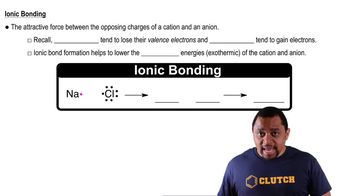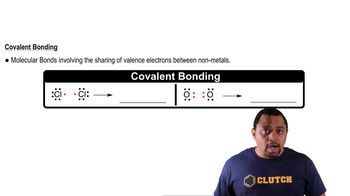Here are the essential concepts you must grasp in order to answer the question correctly.
Ionic Bonding
Ionic bonding occurs when one atom donates one or more electrons to another atom, resulting in the formation of charged ions. Typically, this involves a metal atom losing electrons to become a positively charged cation, while a nonmetal atom gains those electrons to become a negatively charged anion. The electrostatic attraction between these oppositely charged ions creates a strong bond, characteristic of ionic compounds.
Recommended video:
Covalent Bonding
Covalent bonding involves the sharing of electron pairs between atoms, usually between nonmetals. In this type of bond, atoms achieve stability by sharing electrons, which allows them to fill their outer electron shells. Covalent bonds can be single, double, or triple, depending on the number of shared electron pairs, and they can vary in polarity based on the electronegativity of the bonded atoms.
Recommended video:
Nonpolar Covalent Bonding
Nonpolar covalent bonding occurs when two identical nonmetal atoms share electrons equally, resulting in no charge separation. This type of bond typically forms between atoms with similar electronegativities, such as in diatomic molecules like O2 or N2. Because the electron distribution is symmetrical, nonpolar covalent bonds do not create dipoles, making these molecules generally nonpolar in nature.
Recommended video:
 Verified step by step guidance
Verified step by step guidance


